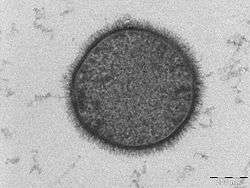Moeller stain
Moeller staining involves the use of a steamed dye reagent in order to increase the stainability of endospores; carbol fuchsin is the primary stain used in this method. Endospores are stained red, while the counterstain methylene blue stains the vegetative bacteria blue.
Endospores are surrounded by a highly resistant spore coat, which is highly resistant to excessive heat, freezing, desiccation, as well as chemical agents. More importantly, for identification, spores are resistant to commonly employed staining techniques; therefore alternative staining methods are required.
Method
Carbol fuchsin is applied to a heat-fixed slide. The slide is then heated over a bunsen burner, or suspended over a hot water bath, covered with a paper towel, and steamed for 3 minutes. The slide is rinsed with acidified ethanol, and counter-stained with Methylene blue. An improved method involves the addition of the surfactant Tergitol 7 to the carbol fuchsin stain, and the omission of the steaming step.[1]
 Endospore
Endospore
See also
Further reading
- Hayama, Masayoshi; Oana, Kozue; Kozakai, Tomonori; Umeda, Shuhei; Fujimoto, Junkoh; Ota, Hiroyoshi; Kawakami, Yoshiyuki (2007). "Proposal of a simplified technique for staining bacterial spores without applying heat - Successful modification of Moeller's method". European Journal of Medical Research. 12 (8): 356–9. hdl:10091/10132. PMID 17933713.
References
- Hayama, M; Oana, K; Kozakai, T; et al. (August 2007). "Proposal of a simplified technique for staining bacterial spores without applying heat--successful modification of Moeller's method". Eur. J. Med. Res. 12: 356–9. PMID 17933713.